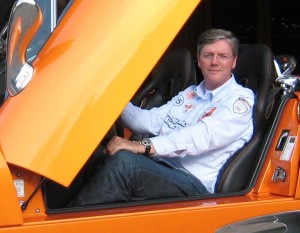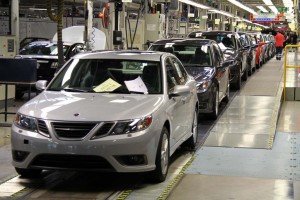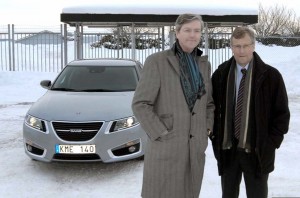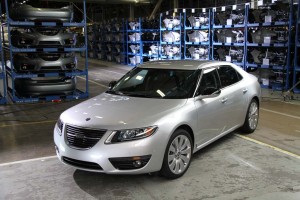
Victor Muller's Spyker pulled off an unexpected coup by acquiring Sweden's Saab from General Motors.
Despite his congenial and seemingly relaxed manner, Victor Muller isn’t a man to waste time.
Joining some journalists for a meal at a hillside restaurant in the Swedish town of Trollhattan, one evening last week, Muller readily fielded questions with only the occasional pause for reflection. When his guests spoke, he’d quickly grab utensils and stab a bite of food, glancing down at a pair of cellphones as he’d chew. When it was time to respond, Muller would exchange fork and knife for two cellphones, a new Blackberry in his right hand for e-mail, a battered old Nokia in his left to handle text messages – often keying in one-handed responses on each as he spoke.
It was a skill the one-time lawyer learned in the days when he was making, rather than spending money, building up a reputation as a mergers-and- acquisition specialists in the Netherlands, then as an entrepreneur, building his bank account with a shipping company and, later, a fashion firm.
But a decade ago, the tall and lanky Dutchman quite literally shifted gears, turning to a more risky, albeit more passionate, series of ventures that now put his comfortable fortune at risk. Muller’s current pursuits bring several biblical references to mind: David and Goliath, perhaps, though the deal he inked barely 100 days ago might better be likened to Jonah swallowing the whale.
In 1999, Muller took the unlikely step of reviving an early Dutch auto company, Spyker Cars, which had gone bust seven decades earlier. Since then, the maker, which specializes in high-performance sports cars commanding prices of $200,000 or more, has racked up sales of just a couple hundred vehicles, but in a series of conversations over the last several years, Muller has seemed un-phased by that modest volume.
Quite the contrary. His business approach seems defined by Spyker’s motto – in Latin, Nulla tenaci invia est via, or, For the tenacious, no road is impassable. Which may be why Muller set off, last November, on what skeptics see as the quixotic attempt to save fast-failing Saab Automobile?
A subsidiary of General Motors, for the previous 20 years, Saab had reportedly run up huge and ongoing losses. Emerging from bankruptcy, and under pressure from the White House, which supplied GM with billions in bailout money, the U.S. maker last year announced it would close or sell off four brands, including Saab.
An initial attempt to sell the Scandinavian carmaker to another Swedish sports car company failed when Konigsegg couldn’t come up with the necessary financing. As 2009 began drawing to a close, GM ordered Saab to start winding down its operations, eventually firing its board and shuttering its plant in Trollhattan, a 90-minute drive from Gothenburg, where larger Volvo is based.
But Muller was convinced the deal could be salvaged and that it was GM’s mismanagement, rather than Saab’s lackluster products and sales that threatened its survival. In November, he wangled a meeting, in Detroit, with the Swedish maker’s CEO Jan Ake Jonsson and negotiators for General Motors.
“I never doubted it was the right thing to do,” he recalls, but Muller realized that with Saab’s operations being dismantled, like a dying patient being pulled off life-support, “every day we waited did more damage.”

The Saab assembly plant, in Trollhattan, was shut down for seven weeks, leaving the maker struggling to fill its pipeline to dealers.
Fortunately, he had the Konigsegg offer and that company’s due diligence report to work from. The key was pulling together the financing. The first big hurdle was cutting his former partner, the Russian financier Vladimir Antonov, out of the picture. GM simply refused to go further until that happened due to concerns about Antonov’s business dealings. But without him, the financing fell short – and Saab kept moving closer and closer to the point of no return.
“It was like playing chess on four boards at once,” Muller says of the negotiations he had underway, not only with GM, but Antonov, the European Investment Bank and the Swedish government. But, ultimately, tenacity did prove it possible to overcome the roadblocks. On January 26, Muller locked down a $400 million package that included just $74 million in cash for GM’s stake in Saab.
Back at the Trollhattan assembly plant, the Dutch entrepreneur looks through a glass wall that gives him a commanding view of the point where finished Saab 9-5 sedans come off the assembly line. Work has wrapped up for the day, leaving dozens of cars idled and waiting to be loaded up for shipment to dealers around the world.
“That’s more cars than Spyker sold all last year,” Muller blurts out, for a moment revealing his own surprise that his long-shot bid has gotten this far.
By the time the deal was completed, the factory had been idled and suppliers told to stop delivering parts. It took seven weeks to resume operations and, at least for the moment, the company has just 5,000 vehicles in showrooms, barely a third of what it needs, especially considering the significance of the new 9-5 launch. In its largest market, there are just 700 of the new sedans on dealer lots, says Mike Colleran, president of Saab’s U.S. subsidiary.
There’s an irony to the fact that the last products developed by GM, including both the 9-5 and a crossover-utility vehicle, the 9-4X, could deliver the long-awaited Saab turnaround – but for a new owner.
Over the years, the U.S. giant invested billions into its former Swedish subsidiary, reportedly running up two decades of consistent losses. For his part, however, Muller questions GM’s accounting. It’s the tenet of his belief that Saab can be saved. He’s convinced that the company actually would have been in the black if it wasn’t for the Detroit equivalent of Hollywood’s notorious accounting system – which can show that even the biggest blockbusters lose money.
For one thing, he suggests, Saab apparently had to carry on its books a faulty plan to market a version of its smaller 9-3 sedan rebadged as the Cadillac BLS. That alone generated about $200 million in red ink.
There were plenty of questionable moves, including GM’s decision to tool the Trollhattan plant up for 190,000 vehicles annually, even though the brand generally chugged along producing less than two-thirds that volume in sales. Even then, Muller insists, Saab could generate substantial profits. At various times during several days of discussion, senior executives including the new owner, Chairman Jonsson and Saab Cars USA chief Colleran, insist they should be able to now break even at anywhere from 70,000 to 85,000 sales annually.
That would still be a stretch based on 2009 sales. But even skeptics believe Saab should do better than last year, one of the worst in industry history, and a time when potential buyers regularly read headlines suggesting the Swedish maker would go out of business. The good news for Saab is that the new 9-5 is generating strong reviews. (Click Here for TheDetroitBureau.com’s first drive of the 2010 Saab 9-5 Aero.) Meanwhile, production is steadily ramping up and expected to jump from 200 a day to more than 300 by the end of June.
At that level, “We’ll make a good profit,” says Muller, fiddling with his rimless glasses.
Potentially, anyway, but he is by no means ready to sit back and start counting his Euros. Saab has plenty of work left to do. It has to complete the transition from the GM system, which has included setting up its own distribution system in 23 markets around the world. It has to not only get the message out that it’s back in business but convince increasingly wary luxury buyers that it offers a good alternative to more stable competitors like Audi, Volvo, BMW and Mercedes-Benz.
To handle that end, the Swedish maker has hired on Adrian Hallmark, a well-respected long-time Volkswagen AG executive.
Then there’s product. Saab had been starving for new models. The last-generation 9-5 was forced to live on for 13 years, twice as long as most competitive offerings. The upcoming 9-4X, due for a 2012 model-year debut, will finally plant Saab in one of the most critical segments in the luxury market. A replacement 9-3 will follow. But “at the top of our wish list,” says Muller, is something he dubs the 9-2.
This compact sedan would tremendously broaden Saab’s reach – and, if Jonsson’s forecast is right, generate a minimum of 30,000 more sales annually. But despite the loan from the European Investment Bank, there’s no money to pull the project beyond the planning stage. The good news, says the Swedish chairman, is that “We have been surprised by the number of potential partners who have approached us about working together.”
One could be Beijing Auto, which acquired the rights to Saab’s older product lines. While neither Jonsson nor Muller will offer up other names, there’s little reason to doubt them. Partnering has become a way of life in an industry where even erstwhile competitors like Renault and Daimler AG – parent of Mercedes-Benz – are working together.
If the 9-2 project does come together, says a senior product planner, it would likely not reach market until 2014, at the earliest. About the same time, Saab hopes to start electrifying its line-up. While a hybrid version of the big 9-5 is possible, the next-generation 9-3 – and a 9-2 – would likely be the primary focus, with full hybrids, plug-ins and even a pure battery-electric vehicle offering under discussion.
Notably, Muller insists, “Spyker is not going to tell Saab how to run its business.” There’s little doubt the ever-confident executive’s voice will be heard, but Jonsson and his management team appear ready to defend their own positions and opinions.
But if the deal works out, Spyker should be able to benefit, as well. The handful of dealers who today sell models like the Aileron could jump to 200 or more as it shares showroom space with many Saab outlets around the world.
Muller’s enthusiasm is surprisingly infectious, and it’s something he counts on as he travels the globe, mingling with journalists, bankers and dealers, hoping to spread Saab’s new gospel. Even so, he knows he has a long battle ahead, not just laying out a case but demonstrating it can work through new products and bigger sales.
Joining his journalist guests for one last afternoon, at a test track an hour from Trollhattan, he watches as they launch the new 9-5 around sharp corners and perform maneuvers in a simulated moose avoidance test – a big issue for Swedes.
After two decades of failed promise under General Motors, he admits, “It will take a lot to restore confidence in this brand.”


